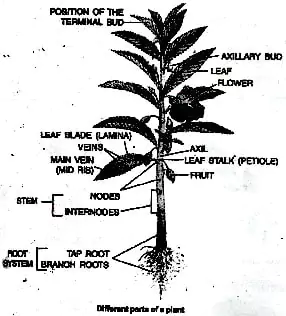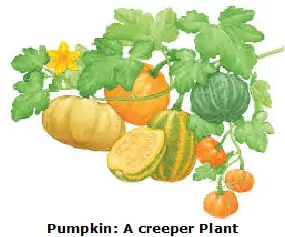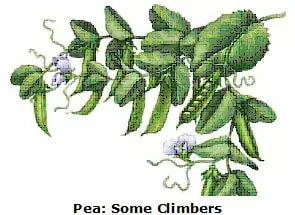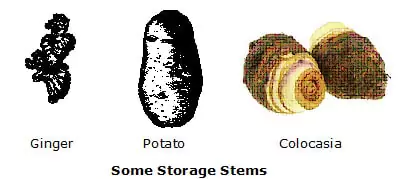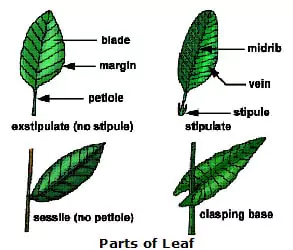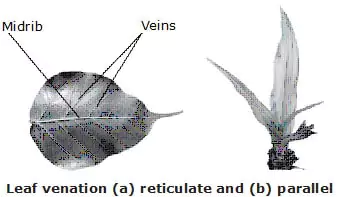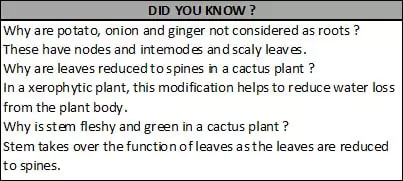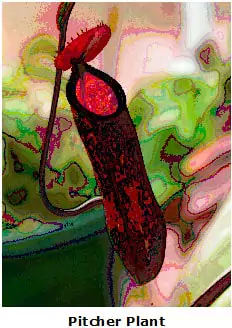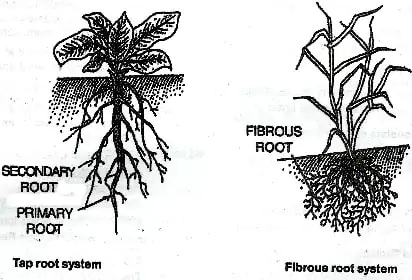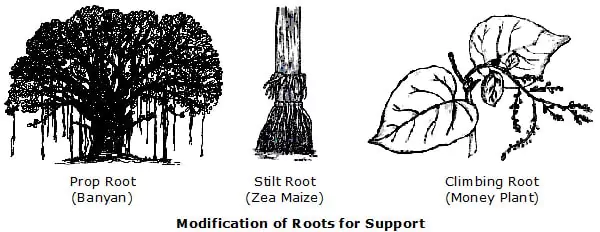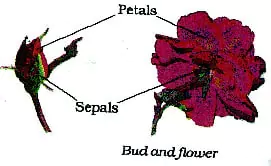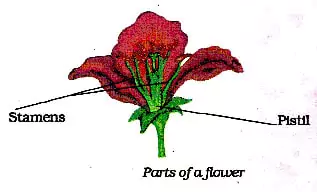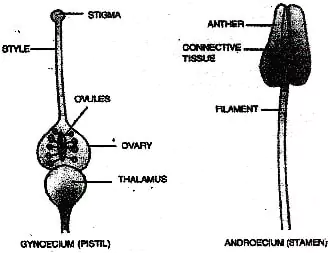INTODUCTION
Plants show a big variety. Some plants are very large, some are small and some are tiny. On the basis of their size and shaps, plants have been divided into the following three categories.
(i) Herbs
(ii) Shrubs
(iii) Trees
Plants with green and tender stems are called herbs. They are usually short and may not have many branches.
Some plants have the stem branching out near the base. The stem is hard but not very thick.
Such plants are called shrubs.
Some plants are very tall and have hard and thick brown stem. The stems have branches in the upper part, much above the ground. Such plants are called trees.
DIFFERENT PARTS OF PLANT
1. Stem 2. Branches 3. Roots 4. Leaves 5. Flower
CREEPERS
Plants with weak stems that can not stand upright and spread on the ground are called creepers eg. Bottie gourd, bitter gourd, pumpkin.
CLIMBERS
Plants which take support on neighbouring structure and climb up are called climbers eg. Betel, grapes, Money plants.
STEM
· The stem is the aerial part on which buds, leaves, flowers and fruits are borne.
· It grows from the plumule of the embryo of a seed.
· It form the main axis that connects the root system with the rest of the plant body.
· It grows away from the soil and towards sunlight.
· The stem may be branched or unbranched.
· The young stem is usually green and soft though it is hard and woody in some plants.
· Stem conduct water.
· Minerals dissolved in water also move up in the stem along with the water.
· The water and minerals go to leaves and other plant part attached to the stem through narrow
tube inside the stem.
· The stem conducts water from roots to the leaves (and other parts) and food from leaves to
other parts of the plant.
· The leaves grow on the stem at difinite points called nodes.
· There may be one or more leaves at a node.
· The part of the stem between two successive nodes is the internode.
· The angle formed between the base of a leaf and the stem is termed as leaf axil.
FUNCTIONS OF STEM
1. Support : It supports branches, leaves, flowers, fruits and buds.
2. Transportation : It helps in the transportation of water and minerals salts absorbed by the
roots of the plant and helps in supply of food from the leaves to various parts of the plant.
3. Food storage : The stem also functions as the storehouse of food material as in case of
potato, garlic, ginger.
4. Climbing : In weak plants like the gourd, bitter gourd the stem gets modified to form tendrils
which help the climbers in climbing.
5. Photosynthesis : The green stem can make food for the plant as in the case of cucuts.
6. Perennation : Certain underground stems like potato, garlic and ginger help the plant to tide
over unfavourable climatic conditions this is called perennation.
MODIFICATION OF THE STEM
(i) Support : In plant such as bean, sweet pototo and morning glory the stem spirals around a
support as it is weak and slender. Climbers are also known as twiners.
(ii) Making food : In plants such as cacti which grow in dry climates, leaves are reduced to spines
or scales to prevent loss of water. Such plants have a flattened or cylindrical green stem to
manufacture food. It also stores food and water for the plant.
(iii) Storage of Food : In some plants the entire stem remains underground and only leaves and
flowering shoots are seen above the ground. It is thickened to store excess food which helps
plants to survive through long bad seasons. Examples are ginger, potato and onion.
LEAF
Terms related to leaf :
(i) Petiole : The parts of a leaf by which it is attached to the stem is called petiole.
(ii) Lamina : The broad green part of the leaf is called lamina.
(iii) Veins : Lines on the leaf are called veins.
(iv) Midrib : A thick vein in the middle of the leaf called the midrib.
(v) Leaf venation : The design made by veins in a leaf is called the leaf venation.
LEAF VENATION IS 2 TYPE
(a) Reticulate venation :
If leaf design made by veins in a leaf is net like on both sides of midrib the venation called
Reticulate. e.g. Leaves of Mango, Pea etc.
(b) Parallel venation :
If veins are parallel to one another in a leaf then venation called parallel venation. eg. leaves of
grass.
FUNCTIONS OF LEAF
1. Manufacturing of Food : The leaf is called “the food factory” of a plant. Green plants make
their own food by the process photosynthesis. Leaves prepare their food in the presence of
sunlight and green coloured substance (chlorophyll) present in them by utillizing carbondioxide
and water by releasing oxygen.
2. Transpiration : The excess of water absorbed by the root hairs lost through the stomata.
Process through which water comes out of leaves in the form of vapour. Plants release a lot of
water into the air through this process.
3. Gaseous exchange : Exchange of gases occurs during respiration and photosynthesis.
4. Vegetative propagation : In some plants, leaves bear buds in the marginal notches from
which new plants grow and develop. eg. Bryophyllum, Begonia.
TYPES OF LEAF
Simple and compound leaves :
(i) A simple of leaf is one that consist of a single lamina, which is not divided into segments.
Plants like mango, guava and money plant have simple leaves.
(ii) A compound leaf is one in which the lamina is divided into several small segments or leaflet
each attached to the same petiole. the leaflet may be arranged on opposite sides of the petiole
like in rose and neem or may arise from a common point at the petiole like in palm leaves.
ARRANGEMENT OF LEAVES
Leaves can be arranged along the stem in different ways.
(i) Alternate arrangement : In some plant, a single leaf grows from each point eg Mango, sunflower and mustard.
(ii) Opposite arrangement : In some plants two leaves grow opposite to each other from the same node. eg. Guava and Tulsi.
MODIFICATION OF THE LEAF
(i) Leaf tendrils : In plants like pea and sweet pea leaves are modified into long, slender, coiled structures called tendrils.
· These are used by the plants for climbing.
· Leaves are used by the plants modified to help the plant climb and support.
(ii) Leaf spines : In cacti and plants such as pineapple the leaves are modified into spines that are sharp, pointed structures.
· These structure protect the plant from grazing animals.
· In dry area, the leaves are reduced to spines to prevent loss of water by transpiration.
(iii) Leaves modified to eat insects : In some insectivorous plants, the leaves are modified into pitcher or bladder like structures to trap, hold and digest insect and small animals.
· These trapped insect are digested within these structures and serve as a source of nitrogen to the plant.
ROOT
The roots help in holding the plant firmly in the soil they are said to anchor the plant to the soil.
TYPE OF ROOT
(1) Tap roots (2) Fibrous Roots
1. Tap roots system :
When a dicot seed (seeds with two seed leaves) germinates, the radicle gives rise to a long deep = seated root.
It is thick and large this is called the primary root or tap root.
· The primary root gets divided into branches which are known as secondary roots.
· The branches of secondary roots are called tertiary roots.
· The primary root is longer than its branches and grows vertically downward into the soil.
· It is found in most of the dicot plants like castor, pea, mango, gram and beams.
2. Fibrous Roots System :
·
In the fibrous root, the primary root is short - lived and is replaced by a cluster of thin fibre like roots.
These are called fibrous roots.
· These roots spread from a common point and are about the same size.
· They spread out in the soil and give firm support to the plant.
· They are found in most of the monocot plants. (Plants that have seeds with single seed - leaf) Like wheat, maize, barley and grasses.
FUNCTIONS OF ROOTS
1. Fixation : It fixes the plant firmly in the soil.
2. Absorption : The root hairs help in the absorption of water and minerals from the soil.
3. Prevention of soil erosion : Roots bind the soil finely and prevent soil erosion.
4. Storage : In plant like carrot, turnip, radish and sweet potato and tapioca, the roots are
modified for the storage of food.
SUPPORTING ROOTS
· In plants such as black pepper, money plant and beetel the roots help the plant to climb up a
support as the stems are too weak to stand on their own Hence they are kown as climbing roots
· In plant such as banyan new roots grow downwards from the main stem or branches. These are
aerial roots that grown towards the soil and act as pillar to support the plant. They are know as
prop roots.
FLOWER
· The Flower is the site of sexual reproduction in plants.
· A flower many be defined as a modified shoot in which nodes and internodes are highly condensed.
· It develops from the floral bud.
Parts of a Flower : Flowers vary in size, shape and colour but all flowers have the same basic parts.
A Flower consists of following parts :
· Pedicel and Thalamus
· Calyx
· Corolla
· Androecium/ stamen/ Male Reproductive organ
· Gynoecium/ Pistils/ Femals Reproductive organ.
(i) Pedical and Thalamus :
· The Flower is borne on a stalk called pedicel.
· The upper most end of the pedicel is some what swollen. This swollen part of the pedicel is
known as the Thalamus.
(ii) Calyx : It is the First outermost whorl of a Flower.
· It consist of leaf like structures called sepals.
· Sepals are generally green in colour and manufacture food.
· They also protect the new delicate inner parts of the flower during the bud stage.
(iii) Corolla : It is the second whorl of a flower.
· Each segment of the corolla is known as a petals.
· Petals are usually brightly coloured due to the presence of pigments.
· The bright colour, sweet smell and nectar attract the insect which in turn, help in pollination.
(iv) Androecium/ stamen/ Male Reproductive organ :
· It is the third floral whorl which is composed of one or more male reproductive organs called
stamen A typical stamen is differentiated into three parts they are filament, connective and anther.
(A) Filament : It is form the stalk that bears more or less cylindrical or ovoid anther
(B) Connective : It connects anther to filament.
(C) Anther : It is present on the top of filament. Each anther consist of two lobes that is why it is
called as bilobed.
· Each anther lobe has two pollen sac which contain millions of tiny micorscopic pollen grain,
called as microspores.
· The pollen grains are like yellow dusty powder in appearance.
(iv) Gynoecium/ Pistils/ Femals Reproductive organ :
· It is located in the centre of flower.
· The gynoecium is the fourth whorl which is composed of one or more carpels.
· The freely occuring units of the carpels in a flower are called pistils.
· Each pistil usually consist of three distinct parts :
(A) ovary (B) Style (C) Stigma
(A) Ovary : It is a basal swollen part of the pistil. The ovary bears the ovules on a raised tissue
called the placenta.
(B) Style : From the top of the ovary arise a long elongated structure which connects the stigma
with ovary. It is meant for raising the level of the stigma.
(C) Stigma : The terminal rough, hairy and sticky.
· The stigma is normally rough, hairy and sticky.
· It is meant for receiving pollen grains during pollination.
Different parts of a flower
· NOTE : Structure of the flower is not always the same. The number of sepals, petals, stamens
and pistils may also be different in different flowers.
· Sometimes, some of these parts may even be absent.
· NOTE : When choosing flowers to study, avoid using Marigold, chrysanthemum and sun flower.
These are not single flowers but group of flowers.
OBJECTIVE TYPE
1. Which one of the following has tap root ?
(A) Wheat (B) Rice (C) Maize (D) Pea
2. Veins are present in ?
(A) Stems (B) roots (C) Leaves (D) None
3. Which part of a flower turns into a fruit ?
(A) Sepals (B) petals (C) Ovary (D) None
4. The leaves of which of the following plants have reticulate venation ?
(A) Wheat (B) Maize (C) Rose (D) Rice
5. The part of the plant that take part in photosynthesis is :
(A) Stem (B) Leaf (C) Flower (D) Root
6. When pollen is transferred to the stigma of another flower the process is called.
(A) Fertilization (B) Fusion (C) Pollination (D) germination
7. The male reproductive organ of a flower is the:
(A) Pistil (B) Stamen (C) Pollengrain (D) Ovule
8. In which plant does the stem perform the function of a leaf ?
(A) Boganvillea (B) Onion (C) Cacti (D) Potato
9. Underground stem can :
(A) Carry out photo synthesis (B) be used to propagate the plant (C) Produce fruit (D) pollinate
10. Which of these plants store food in their roots?
(A) Balsam (B) onion (C) Carrot (D) Zinnia
SUBJECTIVE TYPE
1. If a plant has Fibrous root, what type of venation do its leaves likely to have ?
2. Name the part of the plant which produces its food.
Name this process ?
3. In which part of a flower, you are likely to find the ovarey ?
4. What is the function of a stem in a plant ?
5. With the help of a neat labelled diagram describe the different parts of a flower ?
ANSWER KEY
1. D 2. C 3. C 4. C 5. B 6. C 7. B 8. C
9. B 10. C
MULTIPLE CHOICE QUESTIONS
1. Which of the following combination of features would you observe in grass?
(a) Parallel venation and fibrous root (b) Parallel venation and tap root
(c) Reticulate venation and fibrous root (d) Reticulate venation and tap root
2. Which of the following is the correct match between the characteristics of stem and the category of plant?
(a) weak stem which cannot stand upright: Creeper
(b) green tender stem : Shrub
(c) thick, hard stem with branching near : Tree the base
(d) thick, hard stem with branches high : Herb on the plant
3. Which of the following is not the primary function of stem?
(a) Conduction of water
(b) Photosynthesis
(c) Formation of branches
(d) Bears flowers and fruits
4. Which of the following is not a correct match?
(a) Petiole : attaches leaf to stem
(b) Lamina : green flat part of leaf
(c) Margin : gives shape to the leaf
(d) Veins : transpiration
5. Read the following sentences about photosynthesis:
(i) Sunlight, carbon dioxide, chlorophyll and water are necessary.
(ii) Oxygen is absorbed.
(iii) Leaves carry out photosynthesis.
(iv) Proteins are made during photosynthesis.
Choose the correct pair of sentences that are true to photosynthesis
(a) (iii) and (iv) (b) (i) and (iii)
(c) (ii) and (iv) (d) (i) and (iv)
6. Which of the following terms constitute the female part of the flower.
(a) sepals, petal and stamen
(b) stigma, style and ovary
(c) ovary, stamen and stigma
(d) ovary, style and stamen
VERY SHORT ANSWER QUESTIONS
7. Fill in the blanks
:
(a) The small green leaves at the base of flowers are known as ——————.
(b) The swollen basal part of the pistil is the ————————which bears the —————.
(c) Stamen has two parts called —————— and ——————.
(d) The young unopened flower is termed as ——————.
8. Solve the riddles given below:
(a) “I have a green tender stem and I am much shorter than you. Who am I?”
(b) I come out first from the seed when it is soaked in water.
I provide anchorage to plants. Who am I? Write another function that I perform.
SHORT ANSWER QUESTIONS
9. Match the parts of plant given in Column I with their function in Column II
Column I Column II
(a) Flower (I) Excretion
(b) Leaf (ii) Photosynthesis
(c) Stem (iii) Reproduction
(d) Root (iv) Bears branches
(v) Anchorage
10. Boojho wanted to test the presence of starch in leaves. He performed the following steps.
(1) He took a leaf and boiled it in water,
(2) He placed the leaf in a petri dish and poured some iodine over it.
He did not get the expected result. Which step did he miss? Explain.
11. Will a leaf taken from a potted plant kept in a dark room for a few days turn blue black when tested for starch? Give reasons for your answer.
12. Can the stem of a plant be compared with a street with two–way traffic? Give reason.
LONG ANSWER QUESTIONS
13. Read the function of parts of a plant given below:
(a) fixes plant to the soil
(b) prepares starch
(c) takes part in reproduction
(d) supports branches and bears flowers
In the diagram given in Fig. 1.1, write the names of the parts whose functions you have just read at the appropriate space.
Fig. 1.1
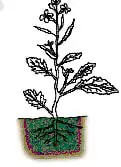
14. Draw the veins of leaves given in Fig. 1.2 below and write the type of venation.
Fig. 1.2
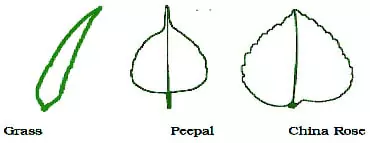
15. Observe Fig. 1.3 and attempt the questions that follow it.
Fig. 1.3
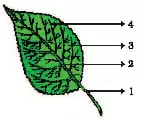
(a) Label the parts 1, 2, 3 and 4 in the diagram.
(b) What type of venation does the leaf has?
(c) What type of venation is seen in grass leaves?
16. Observe the picture of an activity given as Fig. 1.4 carried out with leaves of plants and polythene bag.
Fig. 1.4
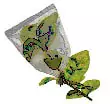
Now answer the following:
(a) Which process is demonstrated in the activity?
(b) When will this activity show better results – on a bright sunny day or a cloudy day?
(c) What will you observe in the polythene bag after a few hours of setting up the activity?
(d) Mention any one precaution you must take while performing this activity.
17. Identify the wrong statements and correct them.
(a) Anther is a part of the pistil.
(b) The visible parts of a bud are the petals.
(c) Lateral roots are present in a tap root.
(d) Leaves perform the function of transpiration only.
18. Solve the crossword given in Fig. 1.5 as per the clues given below it:
Fig. 1.5

Across
1. The term that describes upward movement of water in a stem.
3. The part of leaf which is attached to the stem.
5. This part is attached to the tip of filament.
Down
1. Plants that are weak and spread on the ground.
2. Ovules are present in this part of flower.
4. Is the broad part of leaf.
19. Fill in the blanks with the terms that are listed below:
anther, male, ovary, ovule, petals, pistil, stamen, filament. Sepals, ______(a)______,
stamens and ______(b)______ are the parts of a flower. Stamen is made up of ______
(c)______ and______(d)______ and it represents the ______(e)______ part of the flower. The female part of the flower is called the ______
(f)______. The basal, swollen part of the pistil is called the ______(g)______which contains the ______(h)______.
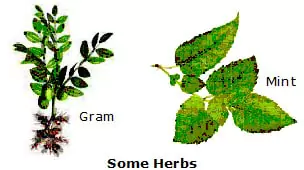
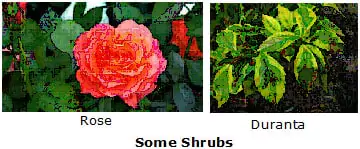
.webp)
